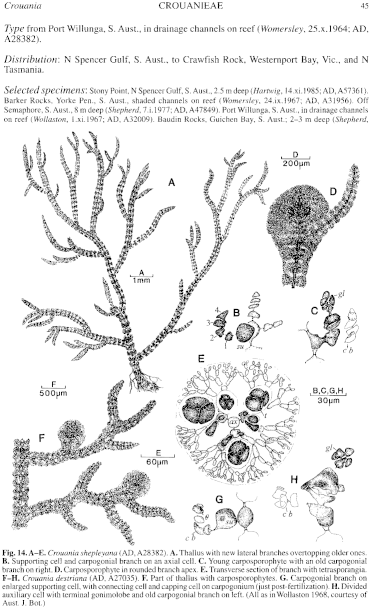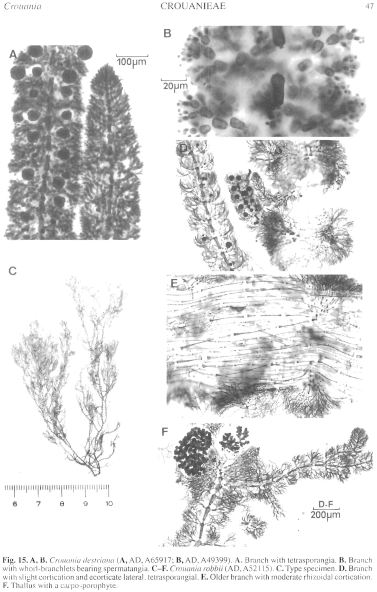|
|
|
|
|
|||||||||||
|
Electronic Flora of South Australia Species Fact Sheet
Phylum Rhodophyta – Order Ceramiales – Family Ceramiaceae – Tribe Crouanieae
Thallus (Fig. 14F) medium red-brown, 5–15 (–20) mm high, slender, much branched irregularly, branches terete, apices obtuse and rounded, axes ecorticate, not mucilaginous, with 3 whorl-branchlets per axial cell. Base creeping on host, attached by rhizoids from numerous axial cells; epiphytic on coralline algae (especially Metagoniolithon). Structure. Apices 2–4 cells long before initiation of whorl-branchlets, cells near apices 7–10 µm in diameter and L/D 0.6–1, increasing to 150–250 µm in diameter and L/D 1–1.2 in lower axes; lateral branches arising from axial cells. Whorl-branchlets closely adjacent along branches (Fig. 15A), near horizontal, 180–250 µm long, branched 6–7 times di- to quadrichotomously, basal cells 12–22 µm in diameter and L/D (1.2–) 1.5–2, tapering to ovoid terminal cells 4–6 µm in diameter and L/D 1–2. Cells uninucleate; rhodoplasts discoid.
Reproduction: Gametophytes dioecious. Procarps (Fig. 14G) developed in place of whorl-branchlets several axial cells below apices, with apical growth ceasing and new branches developing below the carposporophyte; supporting cell relatively large, with a 4-celled carpogonial branch. Post-fertilization a connecting cell fuses with the auxiliary cell and a terminal gonimolobe (Fig. 14H) develops, followed by 1–2 lateral gonimolobes 140–280 µm across, of ovoid carposporangia 25–40 µm in diameter; carposporophytes are surrounded by whorl-branchlets in rounded branch ends (Fig. 14F). Spermatangia (Fig. 15B) are cut off from terminal cells of whorl-branches, ovoid, 2–3 µm in diameter.
Tetrasporangia (Fig. 15A) occur on mid cells of whorl-branchlets, sessile, subspherical, 40–70 µm in diameter, tetrahedrally divided.
Type from D'Estrees Bay, Kangaroo I., S. Aust., drift on Metagoniolithon stelliferum (Wollaston, 23.viii.1963; AD, A27035).
Selected specimens: Tiparra Reef, S. Aust., on Metagoniolithon, 5 m deep (Shepherd, 20.viii.1971; AD, A39466) and on Amphiroa anceps, 7 m deep (Shepherd, 11.i.1978; AD, A49399). Penneshaw, Kangaroo I., S. Aust., on non-geniculate coralline algae on Heterozostera, 7 m deep (Lavers, 12.vii.1996; AD, A65917). Cape Northumberland, S. Aust., on Sporolithon, 2–3 m deep (Edyvane, 5.vi.1982; AD, A55505).
Distribution: Tiparra Reef, Spencer Gulf and Kangaroo I. to Cape Northumberland, S. Aust. (probably more widespread).
Taxonomic notes: This small species of Crouania appears to be confined to the surface of coralline algae, with prostrate axes attached to the host and producing erect branches.
References:
WOLLASTON, E.M. (1968).Morphology and taxonomy of southern Australian genera of Crouanieae Schmitz (Ceramiaceae, Rhodophyta). Aust. J. Bot. 16, 217–417.
The Marine Benthic Flora of Southern Australia Part IIIC complete list of references.
Publication:
Womersley, H.B.S. (24 December, 1998)
The Marine Benthic Flora of Southern Australia
Rhodophyta. Part IIIC. Ceramiales – Ceramiaceae, Dasyaceae
©State Herbarium of South Australia, Government of South Australia
Illustrations in Womersley Part IIIA, 1998: FIGS 14 F–H, 15A, B.

Figure 14 enlarge
Fig. 14. A–E. Crouania shepleyana (AD, A28382). A. Thallus with new lateral branches overtopping older ones. B. Supporting cell and carpogonial branch on an axial cell. C. Young carposporophyte with an old carpogonial branch on right. D. Carposporophyte in rounded branch apex. E. Transverse section of branch with tetrasporangia. F–H. Crouania destriana (AD, A27035). F. Part of thallus with carposporophytes. G. Carpogonial branch on enlarged supporting cell, with connecting cell and capping cell on carpogonium (just post-fertilization). H. Divided auxiliary cell with terminal gonimolobe and old carpogonial branch on left. (All as in Wollaston 1968, courtesy of Aust. J. Bot.)

Figure 15 enlarge
Fig. 15. A, B. Crouania destriana (A, AD, A65917; B, AD, A49399). A. Branch with tetrasporangia. B. Branch with whorl-branchlets bearing spermatangia. C–F. Crouania robbii (AD, A52115). C. Type specimen. D. Branch with slight cortication and ecorticate lateral, tetrasporangial. E. Older branch with moderate rhizoidal cortication. F. Thallus with a carposporophyte.

|
Email Contact: State Herbarium of South Australia |

|